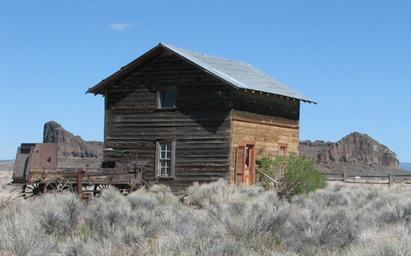Established 1988 Website www.fortrockoregon.com Founded 1988 | Phone +1 541-576-2251 | |
 | ||
Address Old Fort Rock Rd, Fort Rock, OR 97735, USA Hours Closed today TuesdayClosedWednesdayClosedThursday10AM–4PMFriday10AM–4PMSaturday10AM–4PMSunday10AM–4PMMonday10AM–4PM Similar Fort Rock‑Christmas Lake Vall, Fort Rock Cave, Hager Mountain, Fort Rock, Abert Rim Profiles | ||
The Fort Rock Valley Historical Homestead Museum is located in Fort Rock, Oregon, United States. Opened in 1988, it is a collection of original homestead era (early 1900s) buildings including a church, school, houses, homestead cabins, and several other buildings assembled in a village setting. The structures were moved to the museum site from various locations around the Fort Rock Valley, named for volcanic landmark Fort Rock. Most of the buildings contain historic items used by local homesteaders including furniture, dishes, household products, and tools. The museum is open for self-guided tours from mid-March through September.
Contents
History
The Fort Rock Valley covers over 200 square miles (520 km2) at an average elevation of 4,400 feet (1,300 m). From 1905 until about 1915, large numbers of homesteaders moved to the Fort Rock Valley to claim Federal lands for farms and ranches via the Homestead Acts. Numerous small towns were established throughout the valley. These included Fremont, Lake, Sink, Fleetwood, Connley, Arrow, Buffalo, View Point, Cliff, Loma Vista, and Fort Rock. However, the high desert country around Fort Rock has hot, dry summers and extremely cold winters. The valley's average rainfall is less than 9 inches (230 mm) per year, the last average frost date in the spring is June 29 and the average first frost date in the fall is July 9. Because of the extreme weather most homesteaders were forced to abandon their claims within a few years. Most of the valley's towns had post offices by 1912, and most of those post offices were closed by 1920. Today, the only two homesteader-era towns that still exist are the small unincorporated communities of Fort Rock and Silver Lake.
The original vision for the Fort Rock Valley Historical Homestead Museum came from Frank and Vivian Stratton, who both grew up on Fort Rock homesteads. In 1981, the Strattons joined six other individuals interested in local history to form the Fort Rock Valley Historical Society. The society conceived and promoted the development of a homestead museum to preserve the Fort Rock Valley's pioneer heritage. As a result of the society's efforts, the Fort Rock Valley Historical Homestead Museum was opened in 1988 with two historic buildings. Since its opening, the museum has grown significantly, acquiring additional land from the Bureau of Land Management and more buildings from abandoned homestead sites around the Fort Rock Valley. Many of the buildings were considered hazardous and were scheduled to be burned or demolished. The museum's interest saved them from destruction.
Collection
The Fort Rock Valley Historical Homestead Museum docents and volunteers work to preserve, restore, and showcase a living village including an authentic community garden. A seasonal interpretive visitor center and gift shop offers guided tours and independent study of the eleven rescued historic buildings, most of which originate from the Fort Rock Valley. Seasonally evolving indoor and outdoor exhibits of the museum's large collection of homesteaders' furniture, dishes, household products, and tools demonstrate some of the local lifestyles of the period.
Access
The Fort Rock Valley Historical Homestead Museum is located at the main road junction in the small unincorporated community of Fort Rock. The museum is open on Friday, Saturday, and Sunday from mid-May through the end of September. The museum is open for self-guided walking tours from 10:00 a.m. until 4:00 p.m. Arrangements for group tours must be made advance. The visitor center has historic exhibits, books, gifts, and public rest rooms.
